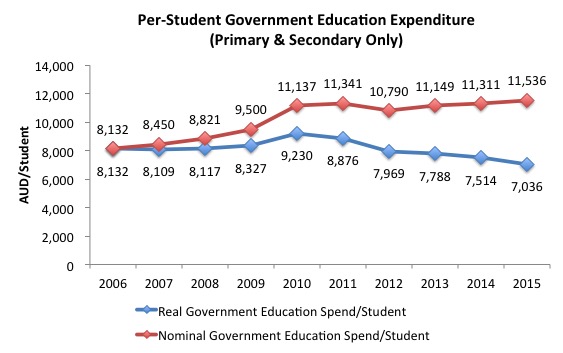Category: Lying with Statistics
Maybe more school spending IS the answer
Following the recent news that Australia has fallen 5 places in the international rankings for science and education performance at an eighth grade level, to 12th of 14 countries measured, the coalition government has taken to saying that the result shows that more money in education does not provide stronger results, and that the governments decision not to fund the last 2 years of the Gonski scheme is the right one. As evidence for its claim the government cites a 49% increase in nominal per-student education spending between 2003 and 2015, a period which saw Australia fall down the international education rankings. The conclusion that we bright citizens are apparently meant to draw is that the increased spending has been entirely wasted and that the coalition governments clever cuts to education spending will get the whole ship in order.
The trouble is that we live in a world where inflation exists, and the thing about inflation is that it means that you can spend more money and still be buying less. If you doubled your weekly coffee budget but the the price of a cup of coffee tripled (or ‘inflated by a stupid amount’, to use some industry lingo) then you could rightly claim to be spending a record amount on coffee, but that wouldn’t change the fact that you were still only getting 2/3 as many cups. The dollar figure would just make that truth a lot harder to see. As such, the governments claims on growth in nominal per-student education spending don’t tell the whole story. Instead, it’s more appropriate to look at real per-student education spending and, wouldn’t you know it, I just happened to have a graph comparing average real and nominal government per-student primary and secondary spending from 2006 to 2015 lying around.

As the graph shows, nominal per-student government expenditure really has increased by an average of 4.0% between 2006 and 2015. The problem is, this hasn’t been enough to keep up with inflation in the education sector, which has averaged 5.2% over the last decade. As a result, real per-student government spending on primary and secondary education has actually fallen by an average of 1.6% per annum over the period.
When the drop in Australian students rankings for science and math is placed into a context where real per-student government spending on primary and secondary education was $1,000 lower in 2015 than in 2006 it suddenly starts to make a lot more sense. It also makes the governments decision not to fund the final 2 years of Gonski look even more cynical.
While there is no doubt that there is more to quality education than just money, the resources available to each student has a very real impact on the ease with kids can realise their academic potential. This isn’t controversial. There is a reason parents spend upwards of $40,000/year to send their kids to private schools. So while the government might say that its decision not to fund the last two years of Gonski will have no effect on education results, it is pretty clear that is going to make turning around the ongoing slide in global rankings a damn sight harder.
What makes the cuts even more infuriating is the news that a third of corporates in Australia paid no tax, including many major multinationals. Instead of taking this as a sign that it can find the necessary funding to offset the plans for education cuts by raising revenue from tax dodging corporates, the government has continued to advocate for a cut in the corporate tax rate that will primarily benefit foreign shareholders thanks to Australia’s dividend imputation system.
Depressingly, the government is making it clear that it feels corporate profits are a greater priority than investing in the education of Australian children. I can’t help but feel that makes it a pretty safe bet that we have yet to see the bottom for Australian achievement in international education rankings.